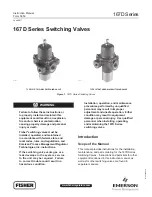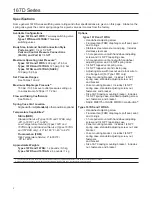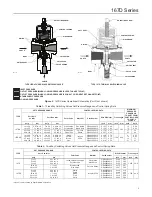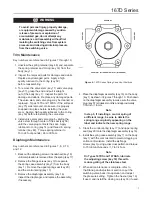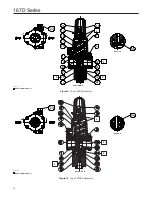
167D Series
6
the lines or from external sources. Switching
valves should be inspected for damage
periodically and after any overpressure condition.
2. Only personnel qualified through training and
experience should install, operate, and maintain
a switching valve. Make sure that there is no
damage to or foreign material in the switching
valve. Also ensure that all tubing and piping is
free of debris.
3. Install the switching valve to achieve the desired
switching results. Connect the control pressure
line to either D port. Verify that the other D port
is plugged. The port labeled “IN” or port A is the
common inlet connection and ports B and C are
the outlet connections. Flow is either from A to B
or A to C.
4. A clogged spring case vent hole may cause the
switching valve to function improperly. To keep
this vent hole from being plugged (and to keep
the spring case from collecting moisture, corrosive
chemicals, or other foreign material) orient the
vent to the lowest possible point on the spring
case or otherwise protect it.
Inspect the vent hole regularly to make
sure it is not plugged. Spring case vent
hole orientation may be changed by rotating the
spring case with respect to the body. A 1/4 NPT
spring case vent may be remotely vented by
installing obstruction-free tubing or piping into
the vent. Protect the remote vent by installing a
screened vent cap on the remote end of the
vent pipe.
5. For use in switching valve shutdown, install
upstream block and vent valves and downstream
block and vent valves (if required), or provide
some other suitable means of properly venting the
switching valves inlet and outlet pressures. Install
a pressure gauge to monitor instruments
on startup.
6. Apply a good grade of pipe compound to the
external pipe threads before making connections,
making sure not to get the pipe compound inside
the switching valves.
7. Install tubing fitting or piping into the threaded NPT
inlet connection on the body (key 1) and into the
threaded NPT outlet connections.
8. The 1/4 NPT control pressure ports must be
plugged if not in use.
Startup and Adjustment
Key numbers are referenced in Figures 7 through 13.
1. With proper installation completed and downstream
equipment properly adjusted, slowly open the
upstream and downstream shut-off valve (when
used) while using pressure gauges to
monitor pressure.
!
WARNING
To avoid personal injury, property
damage, or equipment damage caused
by bursting of pressure containing parts
or explosion of accumulated gas, never
adjust the control spring to produce an
outlet pressure higher than the upper
limit of the outlet pressure range for that
particular spring. If the desired outlet
pressure is not within the range of the
control spring, install a spring of the
proper range according to the diaphragm
parts maintenance procedure.
2. If outlet pressure adjustment is necessary,
monitor outlet pressure with a gauge during the
adjustment procedure. The switching valve
is adjusted by loosening the hexnut (key 19),
if used, and turning the adjusting screw or
handwheel (key 18) clockwise to increase or
counterclockwise to decrease the outlet pressure
setting. Retighten the hexnut to maintain the
adjustment position.
Maintenance
Switching valve parts are subject to normal wear and
must be inspected and replaced as necessary. The
frequency of inspection and replacement of parts
depend on the severity of service conditions and
applicable codes and government regulations.
Note
If sufficient clearance exists, the body
(key 1) may remain mounted on other
equipment or in a line or panel during
maintenance unless the entire switching
valve will be replaced.

